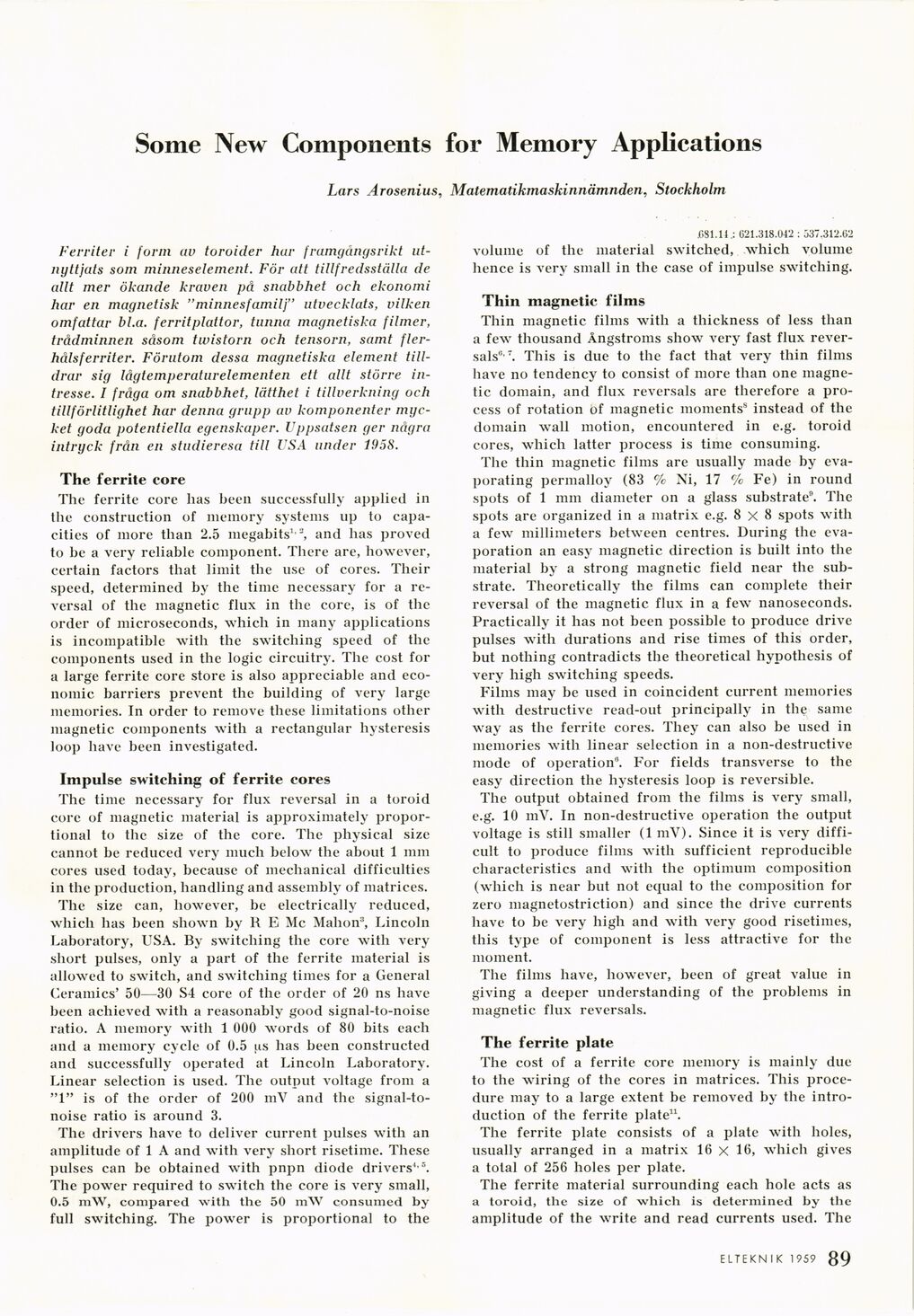
Full resolution (JPEG) - On this page / på denna sida - Some New Components for Memory Applications, by Lars Arosenius

<< prev. page << föreg. sida << >> nästa sida >> next page >>
Below is the raw OCR text
from the above scanned image.
Do you see an error? Proofread the page now!
Här nedan syns maskintolkade texten från faksimilbilden ovan.
Ser du något fel? Korrekturläs sidan nu!
This page has never been proofread. / Denna sida har aldrig korrekturlästs.
Some New Components for Memory Applications
Lars Arosenius, Matematikmaskinnämnden, Stockholm
Ferriter i form av toroider hav framgångsrikt
utnyttjats som minneselement. För att tillfredsställa de
allt mer ökande kraven på snabbhet och ekonomi
har en magnetisk "minnesfamilj" utvecklats, vilken
omfattar bl.a. ferrit plattor, tunna magnetiska filmer,
trådminnen såsom twistorn och tensorn, samt
fler-hålsferriter. Förutom dessa magnetiska element
tilldrar sig lågtemperaturelementen ett allt större
intresse. I fråga om snabbhet, lätthet i tillverkning och
tillförlitlighet har denna grupp av komponenter
mycket goda potentiella egenskaper. Uppsatsen ger några
intryck från en studieresa till USA under 1958.
The ferrite core
The ferrite core has been successfully applied in
tiie construction of memory systems up to
capacities of more than 2.5 megabits1-3, and has proved
to be a very reliable component. There are, however,
certain factors that limit the use of cores. Their
speed, determined by the time necessary for a
reversal of the magnetic flux in the core, is of the
order of microseconds, which in many applications
is incompatible with the switching speed of the
components used in the logic circuitry. The cost for
a large ferrite core store is also appreciable and
economic barriers prevent the building of very large
memories. In order to remove these limitations other
magnetic components with a rectangular hysteresis
loop have been investigated.
Impulse switching of ferrite cores
The time necessary for flux reversal in a toroid
core of magnetic material is approximately
proportional to the size of the core. The physical size
cannot be reduced very much below the about 1 mm
cores used today, because of mechanical difficulties
in the production, handling and assembly of matrices.
The size can, however, be electrically reduced,
which has been shown by R E Mc Mahon3, Lincoln
Laboratory, USA. By switching the core with very
short pulses, only a part of the ferrite material is
allowed to switch, and switching times for a General
Ceramics’ 50—30 S4 core of the order of 20 ns have
been achieved with a reasonably good signal-to-noise
ratio. A memory with 1 000 words of 80 bits each
and a memory cycle of 0.5 us has been constructed
and successfully operated at Lincoln Laboratory.
Linear selection is used. The output voltage from a
"1" is of the order of 200 mV and the
signal-to-noise ratio is around 3.
The drivers have to deliver current pulses with an
amplitude of 1 A and with very short risetime. These
pulses can be obtained with pnpn diode drivers4,5.
The power retpiired to switch the core is very small,
0.5 mW, compared with the 50 mW consumed by
full switching. The power is proportional to the
.681.14.: 621.318.042 : 337.312.62
volume of the material switched, which volume
hence is very small in the case of impulse switching.
Thin magnetic films
Thin magnetic films with a thickness of less than
a few thousand Ångströms show very fast flux
reversals0,7. This is due to the fact that very thin films
have no tendency to consist of more than one
magnetic domain, and flux reversals are therefore a
process of rotation of magnetic moments8 instead of the
domain wall motion, encountered in e.g. toroid
cores, which latter process is time consuming.
The thin magnetic films are usually made by
evaporating permalloy (83 % Ni, 17 % Fe) in round
spots of 1 mm diameter on a glass substrate9. The
spots are organized in a matrix e.g. 8x8 spots with
a few millimeters between centres. During the
evaporation an easy magnetic direction is built into the
material by a strong magnetic field near the
substrate. Theoretically the films can complete their
reversal of the magnetic flux in a few nanoseconds.
Practically it has not been possible to produce drive
pulses with durations and rise times of this order,
but nothing contradicts the theoretical hypothesis of
very high switching speeds.
Films may be used in coincident current memories
with destructive read-out principally in the same
way as the ferrite cores. They can also be used in
memories with linear selection in a non-destructive
mode of operation". F’or fields transverse to the
easy direction the hysteresis loop is reversible.
The output obtained from the films is very small,
e.g. 10 mV. In non-destructive operation the output
voltage is still smaller (1 mV). Since it is very
difficult to produce films with sufficient reproducible
characteristics and with the optimum composition
(which is near but not equal to the composition for
zero magnetostriction) and since the drive currents
have to be verv high and with very good risetimes,
this type of component is less attractive for the
moment.
The films have, however, been of great value in
giving a deeper understanding of the problems in
magnetic flux reversals.
The ferrite plate
The cost of a ferrite core memory is mainly due
to the wiring of the cores in matrices. This
procedure may to a large extent be removed by the
introduction of the ferrite plate11.
The ferrite plate consists of a plate with holes,
usually arranged in a matrix 16 x 16, which gives
a total of 256 holes per plate.
The ferrite material surrounding each hole acts as
a toroid, the size of which is determined by the
amplitude of the write and read currents used. The
ELTEKNIK 1959 1 89
<< prev. page << föreg. sida << >> nästa sida >> next page >>